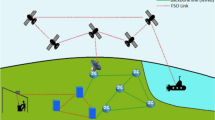Abstract
In this paper, we have proposed a Multiservice Provisioning Optical Code Switching (OCS) method for GMPLS networks, which uses Optical-Code-Division-Multiplexing (OCDM) across every lightpath of a wavelength division multiplexing system. We also presented the router architecture for the GMPLS multiservice network. In this method, the Multi Length Variable Weight Optical Orthogonal Code (MLVW-OOC) is used to multiplex each class (two-class system) service connection to a wavelength as an OCDM signature series. First, the fiber bandwidth has been classified into several wavebands, whose wavelengths are considered for a specific service class depending on the characteristics of that service class. The codes corresponding to the service class are also given in this manuscript. Erlang’s traffic behavior of the network model is used to evaluate the system performance as well as to obtain the probability density functions (PDF) of the number of labels oocupied by a link. We have also evaluated the PDF for the number of labels occupied in each wavelength. Further, we have evaluated the performance of the network in terms of the probability of outage, blocking probability, and the end-to-end (EE) bit error rate (BER) of a connection. The results indicate that interfering users perform better with longer-weight code words. Moreover, with the increase in the number of intermediate OCS routers, EE BER is increased, and it is found that by constraining the number of connected paths, performance can be improved.











Similar content being viewed by others
Data availability
Data sharing not applicable to this article as no datasets were generated or analysed during the current study.
References
Yoo, S. J. B. (2006). Optical packet and burst switching technologies for the future photonic Internet. Journal of Lightwave Technology, 24(12), 4468–4492.
Huang, C. L. I. J., Duan, R., Cui, C., Jiang, J., & Li, L. (2014). Recent progress on c-RAN centralization and cloudification. IEEE Access, 2, 1030–1039.
Roppelt, M., Pohl, F., Grobe, K., Eiselt, M., & Elbers, J. P. (2011). Tuning methods for uncooled low-cost tunable lasers in WDM-PON. In Proceedings of OFC/NFOEC, NTuB1.
Kumar, V. K. A., et al. (2019). Optical burst routing by balanced wavelength allocation under multi-objective quality metrics. Wireless Personal Communications, 107(2), 1093–11142.
Dhinakaran, V., Krithiga, S., & Selvakumar, P. (2022). Dynamic bandwidth allocation using radio over fiber in passive optical network. Wireless Personal Communications. https://doi.org/10.1007/s11277-022-09743-6
Salehi, J. A. (1989). Code division multiple-access techniques in optical fiber networks. I. Fundamental principles. IEEE Transactions on Communications, 37(8), 824–833.
Prucnal, P. R. (2006). Optical code division multiple access. Taylor and Francis.
Wang, Y., et al. (2019). Research on optical code assignment algorithm based on PCE domain. Optical Fiber Technology, 50, 302–308.
Chen, K. S., & Yang, C. C. (2020). An application of spectral-amplitude-coding labels in optical signal buffering over optical packet-switching networks. IEEE Communications Letters, 24(9), 2020–2023.
Chen, K. (2019). Multiple-code technique for multi-rate transmissions in optical packet switching networks based on OCDMA labels. Photonics, 6(2), 1–12. https://doi.org/10.3390/photonics6020060
Beyranvand, H., & Salehi, J. A. (2014). Application of optical multilevel transmission technique in WDM/OCDM-based core networks. IEEE Communications Magazine, 52(8), 116–125.
Beyranvand, H., & Salehi, J. (2009). Multiservices provisioning and quality of service guarantee in WDM optical code switched GMPLS core networks. Journal of Lightwave Technology, 27(12), 1754–1762.
O’Mahoney, M. J., Politi, C., Klonidis, D., Nejabati, R., & Simeonidou, D. (2006). Future optical networks. Journal of Lightwave Technology, 24(12), 4684–4696.
Van Caenegem, R., Colle, D., Pickavet, M., Demeester, P., Christodoulopoulos, K., Vlachos, K., Varvarigos, E., Stampoulidis, L., Roccato, D., & Vilar, R. (2007). The design of an all-optical packet switching network. IEEE Communications Magazine, 45(11), 52–61.
Beyranvand, H., & Salehi, J. A. (2009). All-optical multiservice path switching in optical code switched GMPLS core networks. Journal of Lightwave Technology, 27(12), 2001–2012.
Kitayama, K., & Wada, N. (1999). Photonic IP routing. IEEE Photonic Technology Letters, 11(12), 1689–1691.
Kitayama, K., Wada, N., & Sotobayashi, H. (2000). Architectural considerations of photonic IP router based upon optical code correlation. Journal of Lightwave Technology, 18(12), 1834–1844.
Murata, M., & Kitayama, K. (2001). A perspective on photonic multiprotocol label switching. IEEE Network Magazine, 15(4), 56–63.
Kitayama, K., & Murata, M. (2003). Versatile optical code-based MPLS for circuit, burst, and packet switching. Journal of Lightwave Technology, 21(11), 2753–2764.
Huang, S., Baba, K., Murata, M., & Kitayama, K. (2006). Variable-bandwidth optical paths: Comparison between optical code-labeled path and OCDM path. Journal of Lightwave Technology, 24(10), 3563–3573.
Farnoud, F., Ibrahimi, M., & Salehi, J. A. (2007). A packet-based photonic label switching router for a multirate all-optical CDMA-based GMPLS switch. IEEE Journal of Selected Topics in Quantum Electronics, 13(5), 1522–1530.
Reddy, M. B., Tangaraj, J., & Priye, V. (2019). Multiservice provisioning on generalized multiprotocol label switching optical core networks. In International Conference on Wireless Communications Signal Processing and Networking (WiSPNET).
Mashhadi, S., & Salehi, J. A. (2006). Code division multiple-access technique in optical fiber networks, Part III: Optical AND logic gate receiver structure with generalized optical orthogonal codes. IEEE Transactions on Communications, 54, 1457–1468.
Huang, S., Baba, K., Murata, M., & Kitayama, K. (2008). A study on cycle attack by multiaccess interference in multigranularity OCDM-based optical networks. Journal of Lightwave Technology, 26(14), 2064–2073.
Yang, G. C. (1996). Variable-weight optical orthogonal codes for CDMA network with multiple performance requirements. IEEE Transactions on Communications, 44(1), 47–55.
Kaufman, J. S. (1981). Blocking in a shared resource environment. IEEE Transactions on Communications, 29(10), 1474–1481.
Roberts, J. W. (1981). A service system with heterogeneous user requirements: Application to multi-service telecommunications systems. In G. Pujolle (Ed.), Proceedings of performance of data communications systems and their applications (pp. 423–443). Holland.
Farghal, A. E., Shalaby, H. M. H., & Kawasaki, Z. (2014). Multirate multiservice all-optical code switched GMPLS core network utilizing multicode variable-weight optical code-division multiplexing. Journal of Optical Communications and Networking, 6, 670–683.
Reddy, M. B., Thangaraj, J., & Priye, V. (2020). Performance analysis and modelling of GMPLS optical networks with multiservice queueing model. In International Conference on Electrical and Electronics Engineering (ICE3).
Jinno, M., Takara, H., Kozicki, B., Tsukishima, Y., Sone, Y., & Matsuoka, S. (2009). Spectrum-efficient and scalable elastic optical path network: Architecture, benefits, and enabling technologies. IEEE Communications Magazine, 47(11), 66–73.
Tarhuni, N. G., Korhonen, T. O., Mutafungwa, E., & Elmusrati, M. S. (2006). Multiclass optical orthogonal codes for multiservice optical CDMA networks. Journal of Lightwave Technology, 24(2), 694–704.
Nasaruddin, K., & Tsujioka, T. (2007). Multiple-length variable-weight optical orthogonal codes for supporting multirate multimedia services in optical CDMA networks. IEICE Transactions on Communications, 90(8), 1968–1978.
Chung, F. R. K., Salehi, J. A., & Wei, V. K. (1989). Optical orthogonal codes: Design, analysis, and application. IEEE Transactions on Information Theory, 35(3), 595–604.
Ghaffari, B. M., & Salehi, J. A. (2009). Multiclass, multistage, and multilevel fiber-optic CDMA signaling techniques based on advanced binary optical logic gate elements. IEEE Transactions on Communications, 57(5), 1424–1432.
Kwong, W. C., & Yang, G. C. (2002). Design of multi-length optical orthogonal codes for optical CDMA multimedia networks. IEEE Transactions on Communications, 50(8), 1258–1265.
Lin, J. Y., Jhou, J. S., & Wen, J. H. (2007). Variable-length code construction for incoherent optical CDMA systems. Optical Fiber Technology, 13, 180–190.
Gu, F. R., & Wu, J. (2005). Construction and performance analysis of variable-weight optical orthogonal codes for asynchronous optical CDMA systems. Journal of Lightwave Technology, 23(2), 740–748.
Acknowledgements
We acknowledge the thanks and support provided to us by Department of Electronics Engineering of Indian Institute of Technology (Indian School of Mines), Dhanbad, India.
Funding
The authors declare that no funds, grants, or other support were received during the preparation of this manuscript.
Author information
Authors and Affiliations
Corresponding author
Ethics declarations
Conflict of interest
We wish to confirm that there are no known conflicts of interest associated with this publication and there has been no significant financial support for this work that could have influenced its outcome.
Additional information
Publisher's Note
Springer Nature remains neutral with regard to jurisdictional claims in published maps and institutional affiliations.
Rights and permissions
Springer Nature or its licensor holds exclusive rights to this article under a publishing agreement with the author(s) or other rightsholder(s); author self-archiving of the accepted manuscript version of this article is solely governed by the terms of such publishing agreement and applicable law.
About this article
Cite this article
Reddy, M.B., Thangaraj, J. & Priye, V. Multiservice Provisioning Optical Code Switched Generalized Multiprotocol Label Switching Optical Networks. Wireless Pers Commun 128, 1651–1669 (2023). https://doi.org/10.1007/s11277-022-10013-8
Accepted:
Published:
Issue Date:
DOI: https://doi.org/10.1007/s11277-022-10013-8




